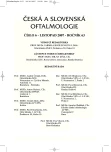Spherical Covering Foil – Silicone Implant Forming Conjunctival Fornices
Authors:
J. Krásný 1; V. Novák 2
Authors‘ workplace:
Oční klinika FN KV a IPVZ, Praha
přednosta prof. MUDr. P. Kuchynka, CSc.
1; Ústav polymerů VŠCHT, Praha, vedoucí prof. ing. V. Dudáček, DrSc.
2
Published in:
Čes. a slov. Oftal., 63, 2007, No. 6, p. 396-402
Overview
Method:
The authors refer about primary development of elastic and sufficiently strong device, which due to its spherical shape bandages the conjunctival space of the palpebral fissure and is used to form the inferior and superior cul-de-sac. It is made from a silicone mixture for medical use – Silastic Medical Grade Elastomer. Its layer in the shape of spherical cap of outer diameter 24.4 mm, height 8.5 mm; the layer thickness is 0.5 mm. Its advantage is the oxygen permeability.
Results:
The spherical covering foil was applied as an arrangement before keratoplasty in four adult men to form fornices after relieving of symblephara reaching the cornea caused by alkali (lime) burn (in three of them) and after liquid aluminium burn (thermal injury). In five years old boy, the spherical covering foil helped to form the palpebral fissure and to improve the eye motility; the symblepharon was related to the inborn coloboma of the upper eyelid. To prevent the symblepharon appearance, the spherical covering foil was used in an adult man after molten polypropylene burn and in an eight years old boy with Stevens – Johnson syndrome.
Conclusion:
The spherical covering foil is used for cul-de-sac forming after relieving of the symblepharon or to prevent its appearance after the eye burn.
Key words:
contact lens, silicone rubber, bandage of the conjunctiva, symblepharon
Labels
OphthalmologyArticle was published in
Czech and Slovak Ophthalmology

2007 Issue 6
Most read in this issue
- Opacification of Hydrophilic Acrylic Intraocular Lenses
- Dry Eye Syndrome in Rheumatoid Arthritis Patients
- Correlation of the Heidelberg Retinal Tomograph, Evaluation of the Retinal Nerve Fiber Layer and Perimetry in the Diagnosis of Glaucoma
- Posterior Capsule Opacification (PCO) Following Implantation of Various Types of IOLs – Part One: The Uncomplicated Course
